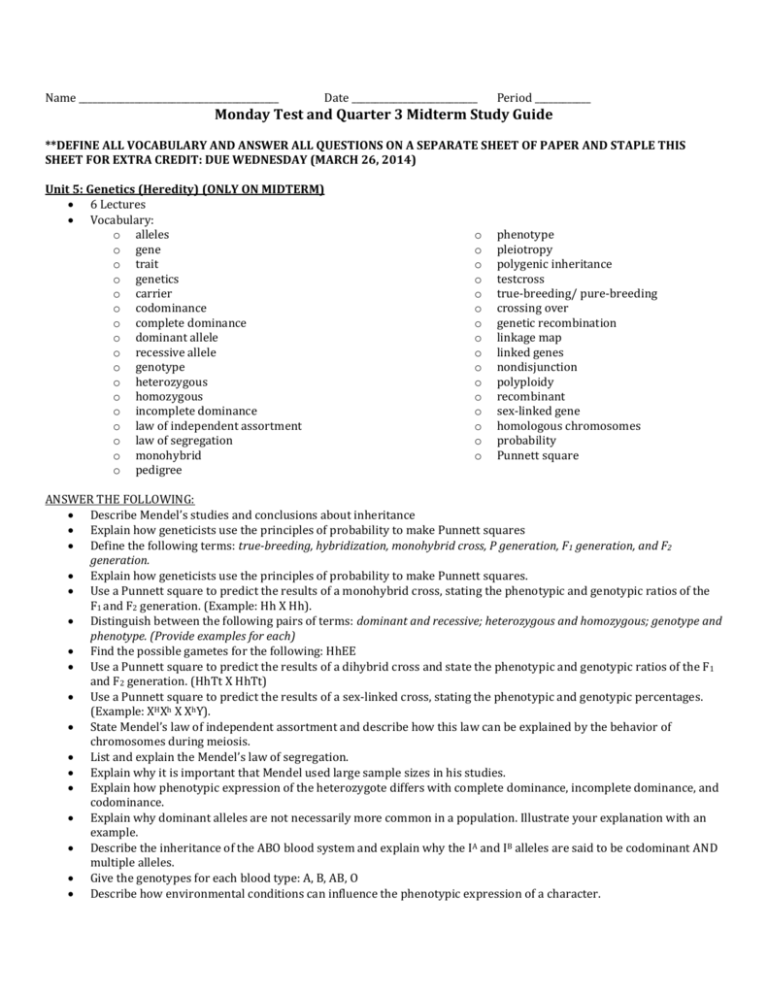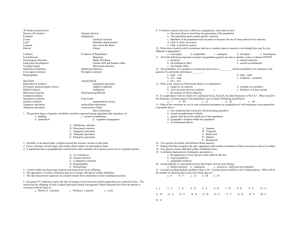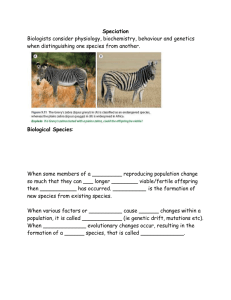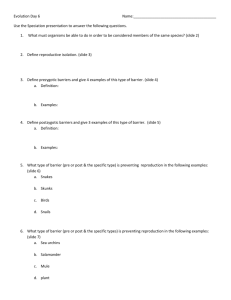Name Date Period ______ Monday Test and Quarter 3 Midterm
advertisement

Name ___________________________________________ Date ___________________________ Period ____________ Monday Test and Quarter 3 Midterm Study Guide **DEFINE ALL VOCABULARY AND ANSWER ALL QUESTIONS ON A SEPARATE SHEET OF PAPER AND STAPLE THIS SHEET FOR EXTRA CREDIT: DUE WEDNESDAY (MARCH 26, 2014) Unit 5: Genetics (Heredity) (ONLY ON MIDTERM) 6 Lectures Vocabulary: o alleles o gene o trait o genetics o carrier o codominance o complete dominance o dominant allele o recessive allele o genotype o heterozygous o homozygous o incomplete dominance o law of independent assortment o law of segregation o monohybrid o pedigree o o o o o o o o o o o o o o o o phenotype pleiotropy polygenic inheritance testcross true-breeding/ pure-breeding crossing over genetic recombination linkage map linked genes nondisjunction polyploidy recombinant sex-linked gene homologous chromosomes probability Punnett square ANSWER THE FOLLOWING: Describe Mendel’s studies and conclusions about inheritance Explain how geneticists use the principles of probability to make Punnett squares Define the following terms: true-breeding, hybridization, monohybrid cross, P generation, F 1 generation, and F2 generation. Explain how geneticists use the principles of probability to make Punnett squares. Use a Punnett square to predict the results of a monohybrid cross, stating the phenotypic and genotypic ratios of the F1 and F2 generation. (Example: Hh X Hh). Distinguish between the following pairs of terms: dominant and recessive; heterozygous and homozygous; genotype and phenotype. (Provide examples for each) Find the possible gametes for the following: HhEE Use a Punnett square to predict the results of a dihybrid cross and state the phenotypic and genotypic ratios of the F1 and F2 generation. (HhTt X HhTt) Use a Punnett square to predict the results of a sex-linked cross, stating the phenotypic and genotypic percentages. (Example: XHXh X XhY). State Mendel’s law of independent assortment and describe how this law can be explained by the behavior of chromosomes during meiosis. List and explain the Mendel’s law of segregation. Explain why it is important that Mendel used large sample sizes in his studies. Explain how phenotypic expression of the heterozygote differs with complete dominance, incomplete dominance, and codominance. Explain why dominant alleles are not necessarily more common in a population. Illustrate your explanation with an example. Describe the inheritance of the ABO blood system and explain why the IA and IB alleles are said to be codominant AND multiple alleles. Give the genotypes for each blood type: A, B, AB, O Describe how environmental conditions can influence the phenotypic expression of a character. Distinguish between the terms phenotype and genotype. Explain why studies of human inheritance are not as easily conducted as Mendel’s work with his peas. Given a simple family pedigree, deduce the genotypes for some of the family members. Explain how pedigrees and karyotypes are used to study human traits. Identify the types of human chromosomes in a karyotype. Explain the process of nondisjunction and the role it plays in meiosis. Summarize the problems caused by nondisjunction. A mutation occurs in a gene on a chromosome. This mutation could be passed along to offspring if it occurs, where? Explain how a lethal recessive allele can be maintained in a population. Explain where linked genes are found and provide an example. Explain why linked genes do not assort independently. Distinguish between linked genes and sex-linked genes. Explain why sex-linked diseases are more common in human males. Unit 6: Evolution (ON MONDAY’S TEST AND MIDTERM) 5 Lectures Vocabulary: o Gradualism o Evolution o Populations o Paleontology/catastrophism o Uniformitarianism o Inheritance o Macroevolution o Coevolution o Convergent Evolution o Divergent Evolution o Tempo of Speciation o Gradualism o Adaptive Radiation o Punctuated Equilibrium o Natural Selection o Variation o Survival of the Fittest o Descent with Modification o Struggle for Existence o Artificial Selection o Adaptation o Fitness o Hardy-Weinberg Equilibrium o Artificial Selection o Allopatric Speciation o Sympatric Speciation o Reproductive Isolation o Prezygotic Isolation o o o o o o o o o o o o o o o o o o o o Postzgotic Isolation Modes of Natural Selection Directional Disruptive Stabilizing Mutation Gene Flow Genetic Drift Bottleneck Effect Founders Effect Gene pool Intersexual selection Intrasexual selection Sexual dimorphism Sexual Selection Comparative Anatomy Homologous Structures Analogous Structures Vestigial Structures Comparative Embryology Molecular Homologies Transitional Fossils Biogeography Vestigial organ Species Speciation ANSWER THE FOLLOWING: Identify common misconceptions about evolution Explain Gradualism, Catastrophism, Uniformitarianism and the influence of these concepts on age of the Earth and it's processes Compare Darwin's theory of evolution and Lamarck's idea of "acquired" characteristics Compare and contrast Artificial Selection and Natural Selection Define and give examples of Adaptations Explain a gene pool, fitness Describe the 3 key concepts of Natural Selection Explain the 5 conditions necessary for a population to be in equilibrium Describe and use the Hardy-Weinberg equilibrium equation to determine allele and genotype frequencies Describe the usefulness of the Hardy-Weinberg model to population geneticists. Distinguish between the bottleneck effect and the founder effect. Define Microevolution and give examples Explain and give examples of the 5 causes of microevolution (natural selection, mutations, gene flow, genetic drift, sexual selection) Describe the 3 modes of natural selection and apply them to different situations Define Macroevolution Explain Macroevolution Processes (coevolution, convergent evolution, divergent evolution) Explain the tempo of speciation (gradualism, adapted radiation and punctuated equilibrium) List Reproductive and Geographic Isolation events that cause speciation and define species Describe speciation events and how they can occur (allopatric/sympatric speciation) Describe the lines of evidence for evolution (Fossil Record, Comparative Anatomy, Embryology, Molecular Biology) Compare homologous, analogous, vestigial structures Define sexual dimorphism and explain how it can influence evolutionary change. Give at least four reasons why natural selection cannot breed perfect organisms. Distinguish between anagenesis and cladogenesis. Define biological species Distinguish between prezygotic and postzygotic isolating mechanisms. Describe five prezygotic isolating mechanisms and give an example of each. Explain why many hybrids are sterile. Distinguish between allopatric and sympatric speciation. Explain, in your own words, how the allopatric speciation model describes the role of variation and geographical isolation. Define sympatric speciation and explain how polyploidy can cause reproductive isolation. List the 7 evidence of evolution and explain how each one shows evidence of evolution. Explain the difference between geographic and reproductive isolation. List the sources of genetic variation ACT questions (ONLY ON MIDTERM) ACT practice Data table interpretation Graph interpretation Grasping key concepts and main points from reading passages








